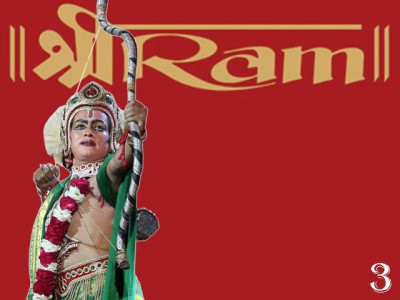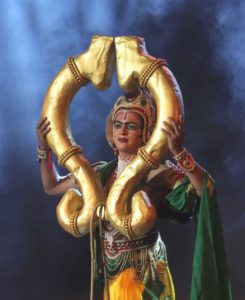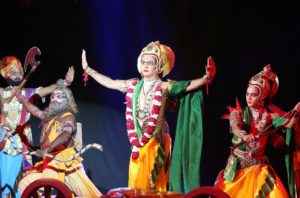Time and space encapsulated in the Ramayana

Shobha Deepak Singh
The Shriram Bharatiya Kala Kendra’s Rama transcends the barriers of spatial and universal time. From the moment that the spectator enters the sacred theatre, his involvement in the performance enables him to relive the myth from present time and space to universal time and space. The thin mesh which stands between his past and his present dissolves and he becomes a partaker in the enactment of the spectacle.
In its resolution to uphold the best in aesthetic tradition, the Kendra attempts every year to work out in detail every department of production values transforming from the earthly to the sublime. The revolving panels function as the wheels of the evolution of time. The music stands silently like a rock, unshakable, forming the back bone of the production.
Other related areas such as sets, lighting and costumes are researched and upgraded continuously in an attempt that the production assumes a towering dimension. The inspiration of rasa that the spectator derives from the Ramlila is something that has defied the vision of spectator for four generations. The divine vision of Ram as delineated in this production is not an instamatic creation. It is indeed the evolution of 45 years of the best in terms of committed creative minds of both big and the small.
This production is no longer a simple event of Inconsequential aesthetic values. Quite to the contrary, it appeals to the classes and the masses for it draws from idioms that area aesthetically sound and which are researched year after year. The spectator is so transported from the mundane to the sublime both in terms of space and time, that he is spellbound and time becomes encapsulated for him. His visit to the sacred theatre yearly reaffirms his faith in the values of the Ramayana that would form the substratum for the future generations.
The production of Rama attempts to link the message of the Ramayana to everyday life of every man. The quintessence of each scene has been conceptualised as leitmotifs of the Ramayana, while the narrative unfolds, as live action, on the stage.
In the presentation of ‘Ram’ there is a play of an irreproachable and ill-starred prince and his faithful princess; of magically flying monkey companions and their enemy the demon King Ravana. These continue to haunt and us long after we have witnessed the performance. It is the Kendra’s efforts to convey something of this enchantment, this haunting sense of a distant yet familiar world that we try to make presentable each successive year.
The plots of Ramayana are ripe with the emotions of life. For elders and necessarily for their children, fascination for the character of ‘Rama’ and ‘Sita’ are unavoidable. It is this, more than anything else that is responsible for its extra ordinary eternal appeal.
The philosophical symbols relate the epic achievements of Maryada Purshottam Rama to the odyssey of Every Man. A brief decoding of the text is from the cosmic to the personal, from eclectic movement to exploration of man’s inner most personal realities and the links thereof.
From the recess of the cave (Kishkindha), Rama found direction of an illuminating beam. This beam helps him to decipher and comprehend the dual nature of time – with a still centre, and a moving circle. The concept of cyclic time, ie, ‘Kaal’ is central to Indian belief. It is in this that lies the key to the contemporary relevance of this epic that would otherwise be reduced to a quasi – historic mythological linear narrative.
This search for the discerning of the divine and the profane, is an urge that lies dormant, unless awakened. In its awakening, it stand in the form of a yantra – that divine space the stage which is a bridge between the visible and the invisible, the consecrated and the ordinary, the blissful and customary. This inner revelation manifests itself in the form of divine ecstasy in realisation of a lotus-like spiritual bloom.
Tomorrow How SBKK Ramlila evolved with time?



